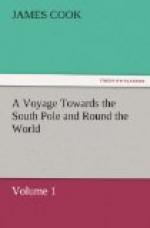1773 November
AT eight o’clock in the evening of the 26th, we took our departure from Cape Palliser, and steered to the south, inclining to the east, having a favourable gale from the N.W. and S.W. We daily saw some rock-weeds, seals, Port Egmont hens, albatrosses, pintadoes, and other peterels.
1773 December
And on the 2d of December, being in the latitude of 48 deg. 23’ south, longitude 179 deg. 16’ west, we saw a number of red-billed penguins, which remained about us for several days. On the 5th, being in the latitude 50 deg. 17’ south, longitude 179 deg. 40’ east, the variation was 18 deg. 25’ east. At half an hour past eight o’clock the next evening, we reckoned ourselves antipodes to our friends in London, consequently as far removed from them as possible.
On the 8th, being in the latitude 55 deg. 39’, longitude 178 deg. 53’ west, we ceased to see penguins and seals, and concluded that those we had seen, retired to the southern parts of New Zealand, whenever it was necessary for them to be at land. We had now a strong gale at N.W., and a great swell from S.W. This swell we got as soon as the south point of New Zealand came in that direction; and as we had had no wind from that quarter the six preceding days, but, on the contrary, it had been at east, north, and N.W., I conclude there can be no land to the southward, under the meridian of New Zealand, but what must lie very far to the south. The two following days we had very stormy weather, sleet and snow, winds between the north and south-west.
The 11th the storm abated, and the weather clearing up, we found the latitude to be 61 deg. 15’ south, longitude 173 deg. 4’ W. This fine weather was of short duration; in the evening, the wind increased to a strong gale at S. W., blew in squalls, attended with thick snow showers, hail, and sleet. The mercury in the thermometer fell to thirty-two; consequently the weather was very cold, and seemed to indicate that ice was not far off.
At four o’clock the next morning, being in the latitude of 62 deg. 10’ south, longitude 172 deg. west, we saw the first ice island, 11 deg. 1/2 farther south than the first ice we saw the preceding year after leaving the Cape of Good Hope. At the time we saw this ice, we also saw an antarctic peterel, some grey albatrosses, and our old companions pintadoes and blue peterels. The wind kept veering from S.W. by the N.W. to N.N.E. for the most part a fresh gale, attended with a thick haze and snow; on which account we steered to the S.E. and E., keeping the wind always on the beam, that it might be in our power to return back nearly on the same track, should our course have been interrupted by any danger whatever. For some days we had a great sea from the N.W. and S.W., so that it is not probable there can be any land near, between these two points.




